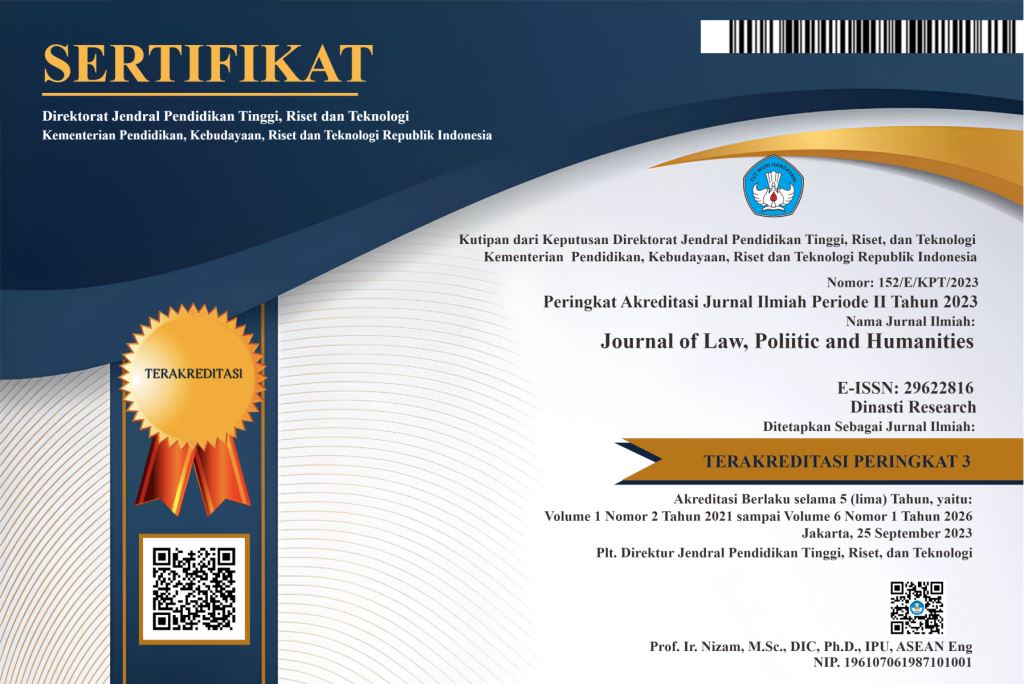Juridical Review of Defamation in the Context of Domestic Violence (KDRT) Evidence Videos Uploaded on Social Media
DOI:
https://doi.org/10.38035/jlph.v5i4.1488Keywords:
Domestic Violence (DV), Defamation, Electronic Information and Transactions Law (ITE Law)Abstract
Social media currently plays a significant role in everyday life, facilitating the sharing of information, including sensitive issues such as Domestic Violence (DV). Uploading videos as evidence of DV is often used as an attempt to seek public support or demand justice. However, this practice poses legal risks, particularly related to defamation, especially if the identity of the affected party is revealed. In Indonesia, defamation is regulated under the Criminal Code (KUHP) and the Electronic Information and Transactions Law (ITE Law), particularly Article 27, paragraph (3), which is frequently applied in social media-related cases. The dilemma arises in balancing the victim's right to disclose their experience of violence with the perpetrator's right to protect their reputation. These cases highlight the challenges of law enforcement in the digital era, where victims often turn to social media due to a lack of trust in formal legal systems, while others may use the law to defend their reputation. Data from the Ministry of Communication and Information (Kominfo) and the National Commission on Violence Against Women (Komnas Perempuan) show an increase in such cases, indicating the need for legal revisions that are more just and responsive to technological advancements and social dynamics.
References
Alviolita, Fifink Praiseda, and Barda Nawawi Arief, ‘Kebijakan Formulasi Tentang Perumusan Tindak Pidana Pencemaran Nama Baik Dalam Pembaharuan Hukum Pidana Di Indonesia’, Law Reform, 15.1 (2019), p. 130, doi:10.14710/lr.v15i1.23359
Amrullah, Arif Fauzan, ‘Analisis Konten Prank KDRT pada Channel YouTube Baim Wong terhadap Perilaku Masyarakat’, JIKA (Jurnal Ilmu Komunikasi Andalan), 5.2 (2023)
Ardiputra, Septiawan, ‘Sosialisasi UU ITE No. 19 Tahun 2016 dan Edukasi Cerdas dan Bijak dalam Bermedia Sosial’, Jurnal Abdi Masyarakat Indonesia, 2.2 (2022), pp. 707–18, doi:10.54082/jamsi.314
Asmadi, Erwin, ‘Rumusan Delik Dan Pemidanaan Bagi Tindak Pidana Pencemaran Nama Baik Di Media Sosial’, 6 (2020)
A., S. W. E., Sjafriani, R. (2010). Kontroversi UU ITE: menggugat pencemaran nama baik di ranah maya. Indonesia: Degraf Pub.
Delik-Delik Tertentu (Speciale Delicten) di dalam KUHP. (2015). Indonesia: Sinar Grafika. Hutabarat, S. A., Praja, S. J., Suhariyanto, D., Paminto, S. R., Kusumastuti, D., Fajrina, R. M., ... & Abas, M. (2023). CYBER-LAW: Quo Vadis Regulasi UU ITE dalam Revolusi Industri 4.0 Menuju Era Society 5.0. PT. Sonpedia Publishing Indonesia.
Junia, ‘Analisis Tentang Pencemaran Nama Baik dan Penyalahgunaan Hak Kebebasan Berpendapat di Media Sosial’, Jurnal Analogi Hukum, 3.2 (2021), pp. 261–65, doi:10.22225/ah.3.2.2021.261-265
Karenisa, Kity, ‘Penghinaan Terhadap Simbol Dan Pejabat Negara Dalam Kajian Linguistik Forensik’, TELAGA BAHASA, 7.1 (2020), pp. 55–72, doi:10.36843/tb.v7i1.57
Kitab Undang-Undang Hukum Pidana (KUHP) Pasal 310, Pasal 311Pasal 27 ayat (3) UU ITE 2008 (sebelum diubah).
Liliana, D. Y., Kom, M., Andryani, N. A. C., Priandana, K., & Fitriyah, H. (2021). Buku Literasi Informasi: Women Against Disruptive Information on Covid-19 Pandemic in Indonesia. Cempluk Aksara.
Mangkepriyanto, E. (2019). Pidana, ITE dan Perlindungan Konsumen. GUEPEDIA.
Marpaung, Leden, 2009, Proses Penanganan Perkara Pidana. Sinar Grafika, Jakarta. Marzuki, Peter Mahmud, 2017, Pengantar Ilmu Hukum, (Jakarta: KENCANA).
Matinya kebebasan berpendapat: ketika para korban UU ITE bertutur. (2021). Indonesia: Parist. Artikel Ilmiah.
Mauliya, Afina, and Triana Rosalina Noor, ‘Cyber Safety dalam Merespon Kekerasan Berbasis Gender Online di Masa Pandemi Covid-19’, Ad- Dariyah: Jurnal Dialektika, Sosial dan Budaya, 3.2 (2023), pp. 82–98, doi:10.55623/ad.v3i2.136
Pasal 45 ayat (3) UU ITE 2016 (setelah diubah)UU 1/2024 tentang perubahan kedua UU ITE Media Elektronik https://www.hukumonline.com/klinik/a/memviralkan-fakta-di-medsos--bisa-kena-pasal-pencemaran-nama-baik-lt5d83b35260ae6/ Diakses 07 September 2024.
Pramana, Darmawan Nuryudha, and ’ Subekti, ‘Bentuk Perlindungan Hukum Korban Online Gender-Based Violence Dalam Peraturan Perundang- Undangan Di Indonesia’, Recidive?: Jurnal Hukum Pidana dan Penanggulangan Kejahatan, 9.2 (2020), p. 161, doi:10.20961/recidive.v9i2.47405
Wibowo, Ari, ‘Kebijakan Kriminalisasi Delik Pencemaran Nama Baik di Indonesia’, 7 (2012)
Winarno, Wahyu Agus, ‘Sebuah Kajian Pada Undang-Undang Informasi Dan Transaksi Elektronik (UU ITE)’, 1 Peraturan Perundang – undangan.
Downloads
Published
How to Cite
Issue
Section
License
Copyright (c) 2025 Robiatul Adawiyah, Nynda Fatmawati O

This work is licensed under a Creative Commons Attribution 4.0 International License.
Authors who publish their manuscripts in this journal agree to the following conditions:
- The copyright on each article belongs to the author(s).
- The author acknowledges that the Journal of Law, Poliitic and Humanities (JLPH) has the right to be the first to publish with a Creative Commons Attribution 4.0 International license (Attribution 4.0 International (CC BY 4.0).
- Authors can submit articles separately, arrange for the non-exclusive distribution of manuscripts that have been published in this journal into other versions (e.g., sent to the author's institutional repository, publication into books, etc.), by acknowledging that the manuscript has been published for the first time in the Journal of Law, Poliitic and Humanities (JLPH).


























